The Importance of Hofstede's Cultural Dimensions in Global Business
VerifiedAdded on 2020/10/22
|7
|1483
|181
Essay
AI Summary
This essay delves into Hofstede's Six Dimensions of Culture model, examining its significance in cross-cultural communication and international business. It highlights the importance of understanding cultural differences, values, and ethics in a global context. The essay discusses the relevance of the model in adapting business operations, setting benchmarks, and motivating employees in diverse environments. It also provides suggestions for improving the model, such as proper management, employee rights, and regular interaction. The author agrees with the importance of proper communication and flexible working environments, while disagreeing with regular performance analysis. The essay concludes by emphasizing the role of Hofstede's model in understanding cultural differences and fostering effective communication and ethical business practices. The provided solution is contributed by a student to be published on Desklib.

Study Skills for Higher
Education
Education
Paraphrase This Document
Need a fresh take? Get an instant paraphrase of this document with our AI Paraphraser
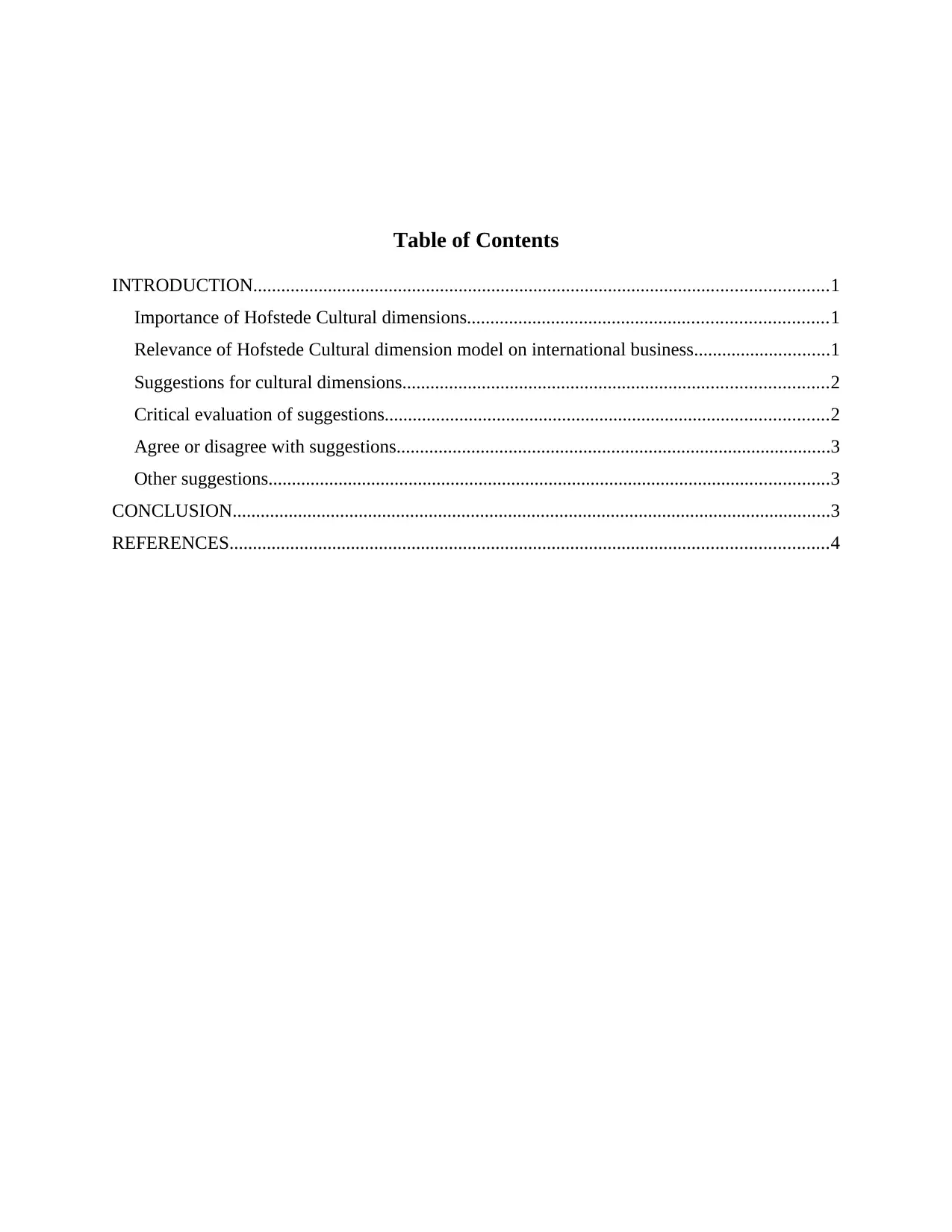
Table of Contents
INTRODUCTION...........................................................................................................................1
Importance of Hofstede Cultural dimensions.............................................................................1
Relevance of Hofstede Cultural dimension model on international business.............................1
Suggestions for cultural dimensions...........................................................................................2
Critical evaluation of suggestions...............................................................................................2
Agree or disagree with suggestions.............................................................................................3
Other suggestions........................................................................................................................3
CONCLUSION................................................................................................................................3
REFERENCES................................................................................................................................4
INTRODUCTION...........................................................................................................................1
Importance of Hofstede Cultural dimensions.............................................................................1
Relevance of Hofstede Cultural dimension model on international business.............................1
Suggestions for cultural dimensions...........................................................................................2
Critical evaluation of suggestions...............................................................................................2
Agree or disagree with suggestions.............................................................................................3
Other suggestions........................................................................................................................3
CONCLUSION................................................................................................................................3
REFERENCES................................................................................................................................4

⊘ This is a preview!⊘
Do you want full access?
Subscribe today to unlock all pages.

Trusted by 1+ million students worldwide
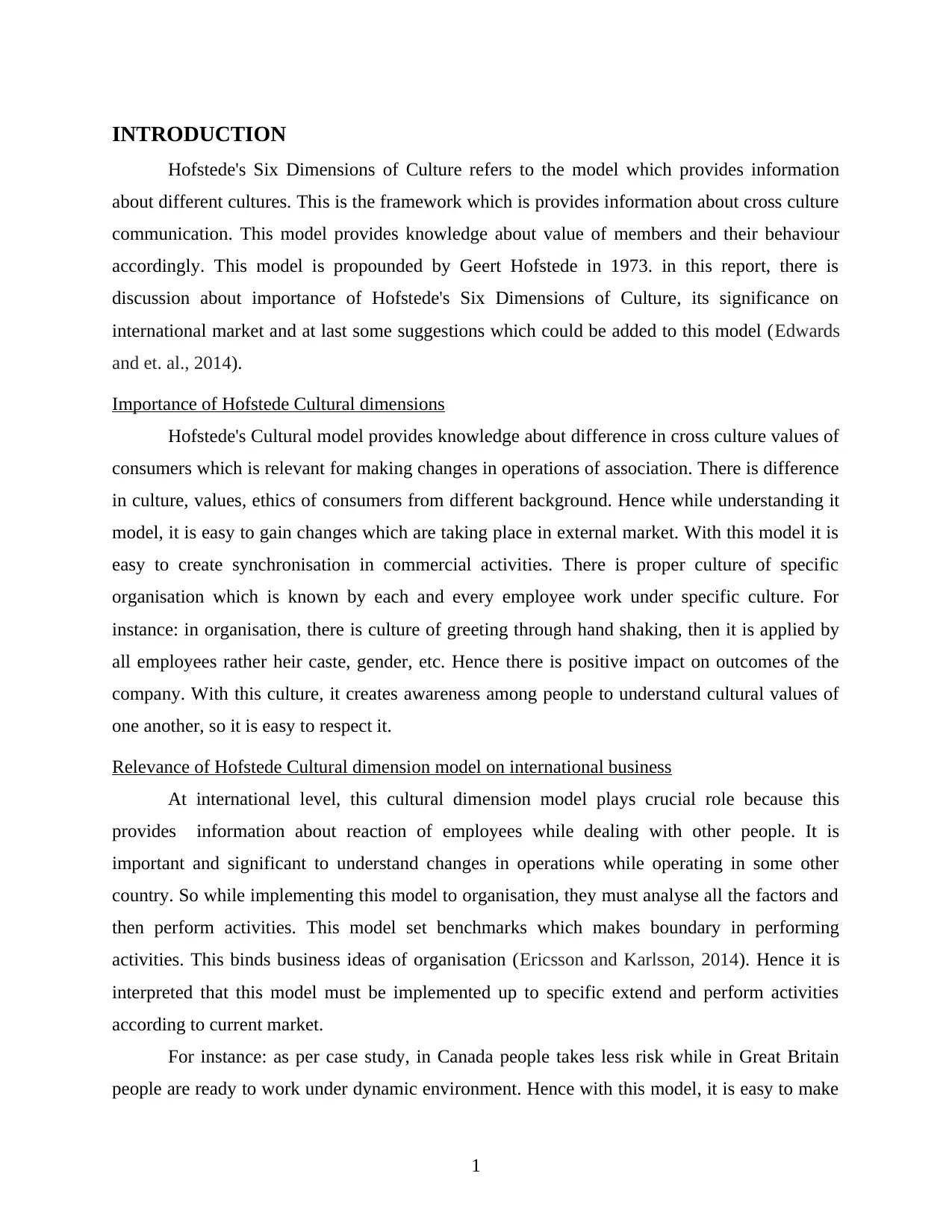
INTRODUCTION
Hofstede's Six Dimensions of Culture refers to the model which provides information
about different cultures. This is the framework which is provides information about cross culture
communication. This model provides knowledge about value of members and their behaviour
accordingly. This model is propounded by Geert Hofstede in 1973. in this report, there is
discussion about importance of Hofstede's Six Dimensions of Culture, its significance on
international market and at last some suggestions which could be added to this model (Edwards
and et. al., 2014).
Importance of Hofstede Cultural dimensions
Hofstede's Cultural model provides knowledge about difference in cross culture values of
consumers which is relevant for making changes in operations of association. There is difference
in culture, values, ethics of consumers from different background. Hence while understanding it
model, it is easy to gain changes which are taking place in external market. With this model it is
easy to create synchronisation in commercial activities. There is proper culture of specific
organisation which is known by each and every employee work under specific culture. For
instance: in organisation, there is culture of greeting through hand shaking, then it is applied by
all employees rather heir caste, gender, etc. Hence there is positive impact on outcomes of the
company. With this culture, it creates awareness among people to understand cultural values of
one another, so it is easy to respect it.
Relevance of Hofstede Cultural dimension model on international business
At international level, this cultural dimension model plays crucial role because this
provides information about reaction of employees while dealing with other people. It is
important and significant to understand changes in operations while operating in some other
country. So while implementing this model to organisation, they must analyse all the factors and
then perform activities. This model set benchmarks which makes boundary in performing
activities. This binds business ideas of organisation (Ericsson and Karlsson, 2014). Hence it is
interpreted that this model must be implemented up to specific extend and perform activities
according to current market.
For instance: as per case study, in Canada people takes less risk while in Great Britain
people are ready to work under dynamic environment. Hence with this model, it is easy to make
1
Hofstede's Six Dimensions of Culture refers to the model which provides information
about different cultures. This is the framework which is provides information about cross culture
communication. This model provides knowledge about value of members and their behaviour
accordingly. This model is propounded by Geert Hofstede in 1973. in this report, there is
discussion about importance of Hofstede's Six Dimensions of Culture, its significance on
international market and at last some suggestions which could be added to this model (Edwards
and et. al., 2014).
Importance of Hofstede Cultural dimensions
Hofstede's Cultural model provides knowledge about difference in cross culture values of
consumers which is relevant for making changes in operations of association. There is difference
in culture, values, ethics of consumers from different background. Hence while understanding it
model, it is easy to gain changes which are taking place in external market. With this model it is
easy to create synchronisation in commercial activities. There is proper culture of specific
organisation which is known by each and every employee work under specific culture. For
instance: in organisation, there is culture of greeting through hand shaking, then it is applied by
all employees rather heir caste, gender, etc. Hence there is positive impact on outcomes of the
company. With this culture, it creates awareness among people to understand cultural values of
one another, so it is easy to respect it.
Relevance of Hofstede Cultural dimension model on international business
At international level, this cultural dimension model plays crucial role because this
provides information about reaction of employees while dealing with other people. It is
important and significant to understand changes in operations while operating in some other
country. So while implementing this model to organisation, they must analyse all the factors and
then perform activities. This model set benchmarks which makes boundary in performing
activities. This binds business ideas of organisation (Ericsson and Karlsson, 2014). Hence it is
interpreted that this model must be implemented up to specific extend and perform activities
according to current market.
For instance: as per case study, in Canada people takes less risk while in Great Britain
people are ready to work under dynamic environment. Hence with this model, it is easy to make
1
Paraphrase This Document
Need a fresh take? Get an instant paraphrase of this document with our AI Paraphraser
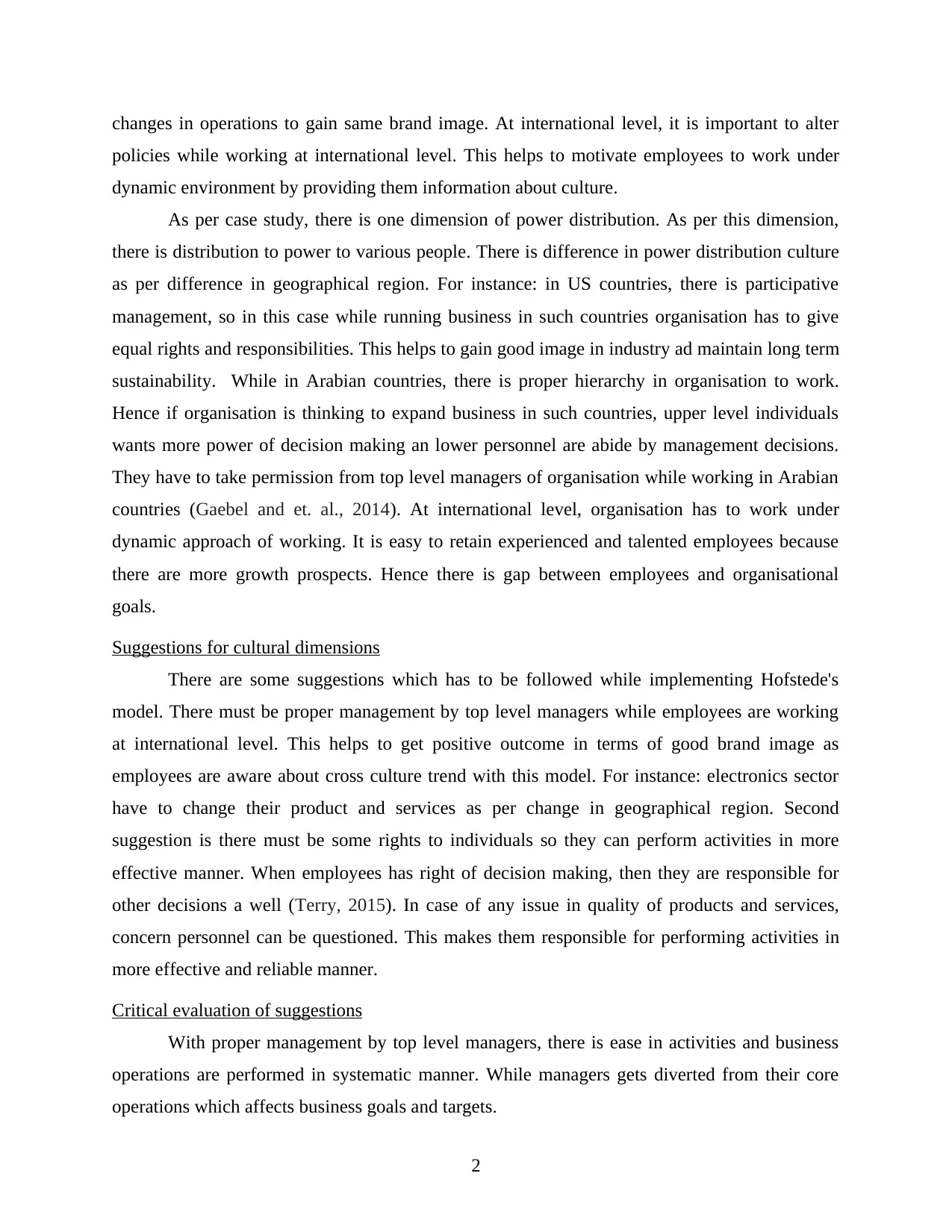
changes in operations to gain same brand image. At international level, it is important to alter
policies while working at international level. This helps to motivate employees to work under
dynamic environment by providing them information about culture.
As per case study, there is one dimension of power distribution. As per this dimension,
there is distribution to power to various people. There is difference in power distribution culture
as per difference in geographical region. For instance: in US countries, there is participative
management, so in this case while running business in such countries organisation has to give
equal rights and responsibilities. This helps to gain good image in industry ad maintain long term
sustainability. While in Arabian countries, there is proper hierarchy in organisation to work.
Hence if organisation is thinking to expand business in such countries, upper level individuals
wants more power of decision making an lower personnel are abide by management decisions.
They have to take permission from top level managers of organisation while working in Arabian
countries (Gaebel and et. al., 2014). At international level, organisation has to work under
dynamic approach of working. It is easy to retain experienced and talented employees because
there are more growth prospects. Hence there is gap between employees and organisational
goals.
Suggestions for cultural dimensions
There are some suggestions which has to be followed while implementing Hofstede's
model. There must be proper management by top level managers while employees are working
at international level. This helps to get positive outcome in terms of good brand image as
employees are aware about cross culture trend with this model. For instance: electronics sector
have to change their product and services as per change in geographical region. Second
suggestion is there must be some rights to individuals so they can perform activities in more
effective manner. When employees has right of decision making, then they are responsible for
other decisions a well (Terry, 2015). In case of any issue in quality of products and services,
concern personnel can be questioned. This makes them responsible for performing activities in
more effective and reliable manner.
Critical evaluation of suggestions
With proper management by top level managers, there is ease in activities and business
operations are performed in systematic manner. While managers gets diverted from their core
operations which affects business goals and targets.
2
policies while working at international level. This helps to motivate employees to work under
dynamic environment by providing them information about culture.
As per case study, there is one dimension of power distribution. As per this dimension,
there is distribution to power to various people. There is difference in power distribution culture
as per difference in geographical region. For instance: in US countries, there is participative
management, so in this case while running business in such countries organisation has to give
equal rights and responsibilities. This helps to gain good image in industry ad maintain long term
sustainability. While in Arabian countries, there is proper hierarchy in organisation to work.
Hence if organisation is thinking to expand business in such countries, upper level individuals
wants more power of decision making an lower personnel are abide by management decisions.
They have to take permission from top level managers of organisation while working in Arabian
countries (Gaebel and et. al., 2014). At international level, organisation has to work under
dynamic approach of working. It is easy to retain experienced and talented employees because
there are more growth prospects. Hence there is gap between employees and organisational
goals.
Suggestions for cultural dimensions
There are some suggestions which has to be followed while implementing Hofstede's
model. There must be proper management by top level managers while employees are working
at international level. This helps to get positive outcome in terms of good brand image as
employees are aware about cross culture trend with this model. For instance: electronics sector
have to change their product and services as per change in geographical region. Second
suggestion is there must be some rights to individuals so they can perform activities in more
effective manner. When employees has right of decision making, then they are responsible for
other decisions a well (Terry, 2015). In case of any issue in quality of products and services,
concern personnel can be questioned. This makes them responsible for performing activities in
more effective and reliable manner.
Critical evaluation of suggestions
With proper management by top level managers, there is ease in activities and business
operations are performed in systematic manner. While managers gets diverted from their core
operations which affects business goals and targets.
2
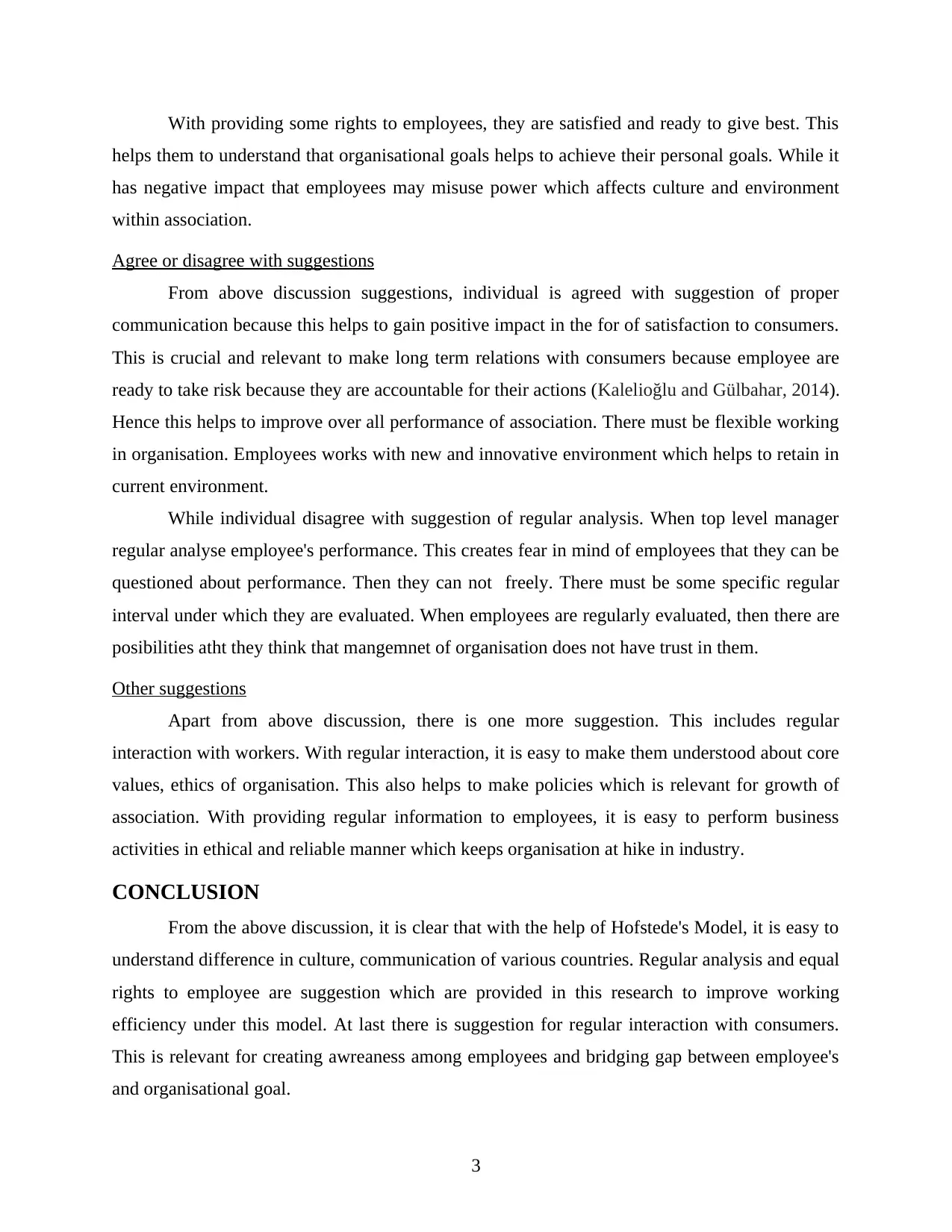
With providing some rights to employees, they are satisfied and ready to give best. This
helps them to understand that organisational goals helps to achieve their personal goals. While it
has negative impact that employees may misuse power which affects culture and environment
within association.
Agree or disagree with suggestions
From above discussion suggestions, individual is agreed with suggestion of proper
communication because this helps to gain positive impact in the for of satisfaction to consumers.
This is crucial and relevant to make long term relations with consumers because employee are
ready to take risk because they are accountable for their actions (Kalelioğlu and Gülbahar, 2014).
Hence this helps to improve over all performance of association. There must be flexible working
in organisation. Employees works with new and innovative environment which helps to retain in
current environment.
While individual disagree with suggestion of regular analysis. When top level manager
regular analyse employee's performance. This creates fear in mind of employees that they can be
questioned about performance. Then they can not freely. There must be some specific regular
interval under which they are evaluated. When employees are regularly evaluated, then there are
posibilities atht they think that mangemnet of organisation does not have trust in them.
Other suggestions
Apart from above discussion, there is one more suggestion. This includes regular
interaction with workers. With regular interaction, it is easy to make them understood about core
values, ethics of organisation. This also helps to make policies which is relevant for growth of
association. With providing regular information to employees, it is easy to perform business
activities in ethical and reliable manner which keeps organisation at hike in industry.
CONCLUSION
From the above discussion, it is clear that with the help of Hofstede's Model, it is easy to
understand difference in culture, communication of various countries. Regular analysis and equal
rights to employee are suggestion which are provided in this research to improve working
efficiency under this model. At last there is suggestion for regular interaction with consumers.
This is relevant for creating awreaness among employees and bridging gap between employee's
and organisational goal.
3
helps them to understand that organisational goals helps to achieve their personal goals. While it
has negative impact that employees may misuse power which affects culture and environment
within association.
Agree or disagree with suggestions
From above discussion suggestions, individual is agreed with suggestion of proper
communication because this helps to gain positive impact in the for of satisfaction to consumers.
This is crucial and relevant to make long term relations with consumers because employee are
ready to take risk because they are accountable for their actions (Kalelioğlu and Gülbahar, 2014).
Hence this helps to improve over all performance of association. There must be flexible working
in organisation. Employees works with new and innovative environment which helps to retain in
current environment.
While individual disagree with suggestion of regular analysis. When top level manager
regular analyse employee's performance. This creates fear in mind of employees that they can be
questioned about performance. Then they can not freely. There must be some specific regular
interval under which they are evaluated. When employees are regularly evaluated, then there are
posibilities atht they think that mangemnet of organisation does not have trust in them.
Other suggestions
Apart from above discussion, there is one more suggestion. This includes regular
interaction with workers. With regular interaction, it is easy to make them understood about core
values, ethics of organisation. This also helps to make policies which is relevant for growth of
association. With providing regular information to employees, it is easy to perform business
activities in ethical and reliable manner which keeps organisation at hike in industry.
CONCLUSION
From the above discussion, it is clear that with the help of Hofstede's Model, it is easy to
understand difference in culture, communication of various countries. Regular analysis and equal
rights to employee are suggestion which are provided in this research to improve working
efficiency under this model. At last there is suggestion for regular interaction with consumers.
This is relevant for creating awreaness among employees and bridging gap between employee's
and organisational goal.
3
⊘ This is a preview!⊘
Do you want full access?
Subscribe today to unlock all pages.

Trusted by 1+ million students worldwide
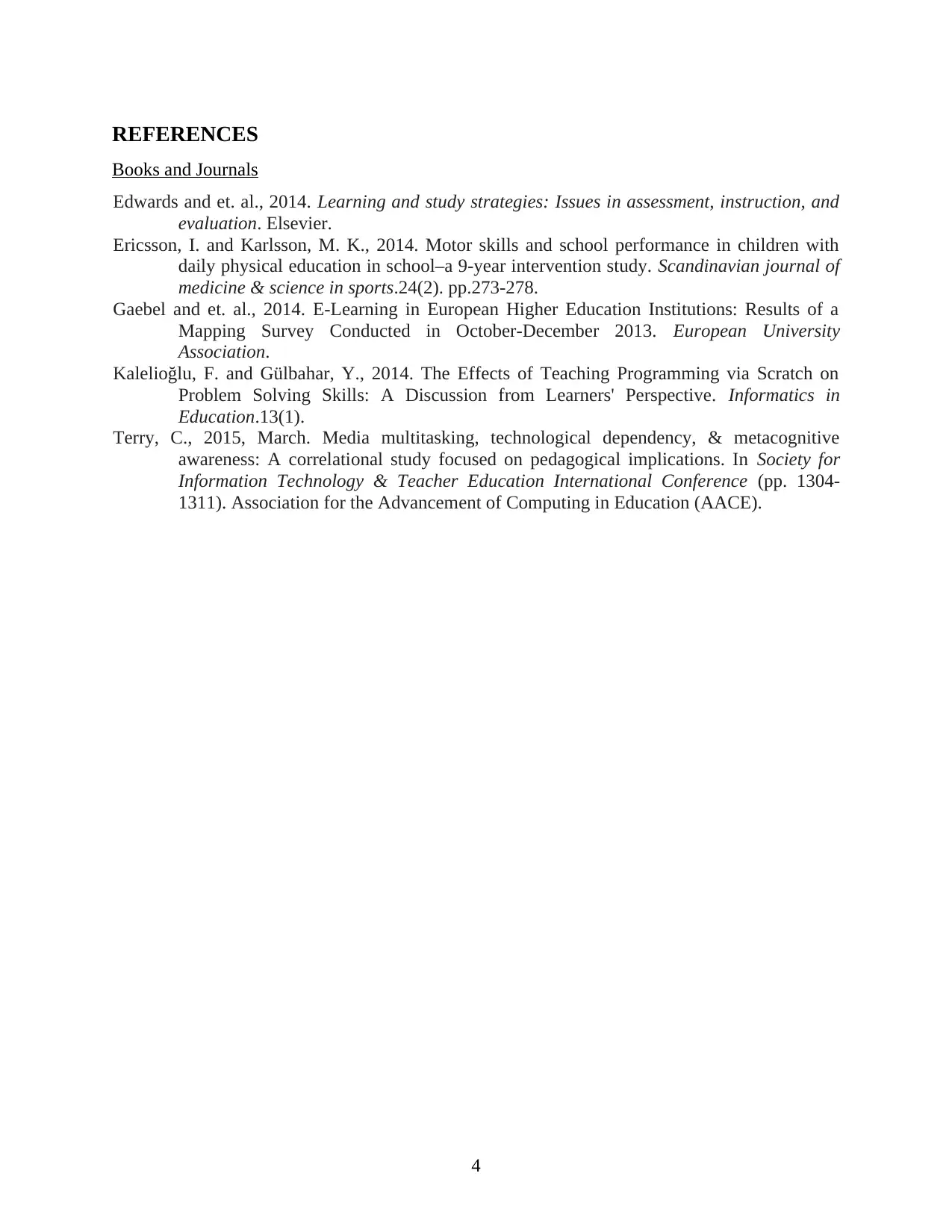
REFERENCES
Books and Journals
Edwards and et. al., 2014. Learning and study strategies: Issues in assessment, instruction, and
evaluation. Elsevier.
Ericsson, I. and Karlsson, M. K., 2014. Motor skills and school performance in children with
daily physical education in school–a 9‐year intervention study. Scandinavian journal of
medicine & science in sports.24(2). pp.273-278.
Gaebel and et. al., 2014. E-Learning in European Higher Education Institutions: Results of a
Mapping Survey Conducted in October-December 2013. European University
Association.
Kalelioğlu, F. and Gülbahar, Y., 2014. The Effects of Teaching Programming via Scratch on
Problem Solving Skills: A Discussion from Learners' Perspective. Informatics in
Education.13(1).
Terry, C., 2015, March. Media multitasking, technological dependency, & metacognitive
awareness: A correlational study focused on pedagogical implications. In Society for
Information Technology & Teacher Education International Conference (pp. 1304-
1311). Association for the Advancement of Computing in Education (AACE).
4
Books and Journals
Edwards and et. al., 2014. Learning and study strategies: Issues in assessment, instruction, and
evaluation. Elsevier.
Ericsson, I. and Karlsson, M. K., 2014. Motor skills and school performance in children with
daily physical education in school–a 9‐year intervention study. Scandinavian journal of
medicine & science in sports.24(2). pp.273-278.
Gaebel and et. al., 2014. E-Learning in European Higher Education Institutions: Results of a
Mapping Survey Conducted in October-December 2013. European University
Association.
Kalelioğlu, F. and Gülbahar, Y., 2014. The Effects of Teaching Programming via Scratch on
Problem Solving Skills: A Discussion from Learners' Perspective. Informatics in
Education.13(1).
Terry, C., 2015, March. Media multitasking, technological dependency, & metacognitive
awareness: A correlational study focused on pedagogical implications. In Society for
Information Technology & Teacher Education International Conference (pp. 1304-
1311). Association for the Advancement of Computing in Education (AACE).
4
1 out of 7
Related Documents
Your All-in-One AI-Powered Toolkit for Academic Success.
+13062052269
info@desklib.com
Available 24*7 on WhatsApp / Email
![[object Object]](/_next/static/media/star-bottom.7253800d.svg)
Unlock your academic potential
Copyright © 2020–2025 A2Z Services. All Rights Reserved. Developed and managed by ZUCOL.





